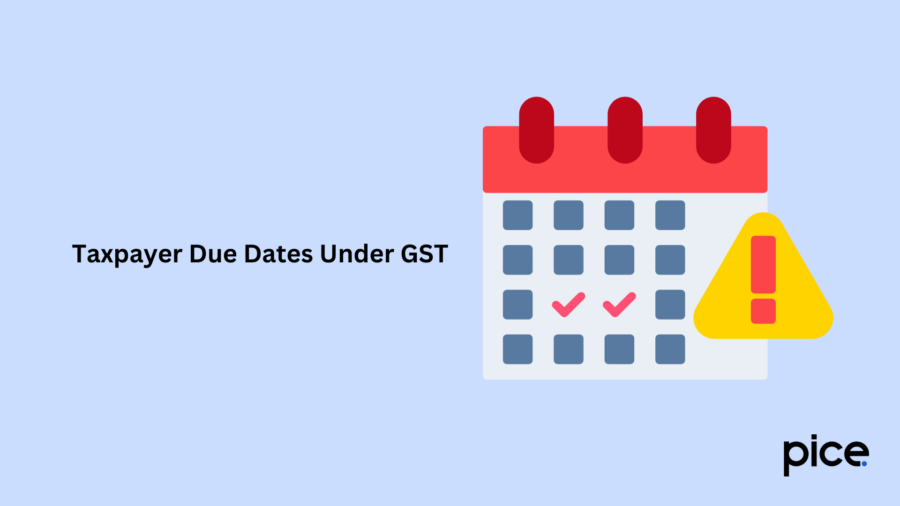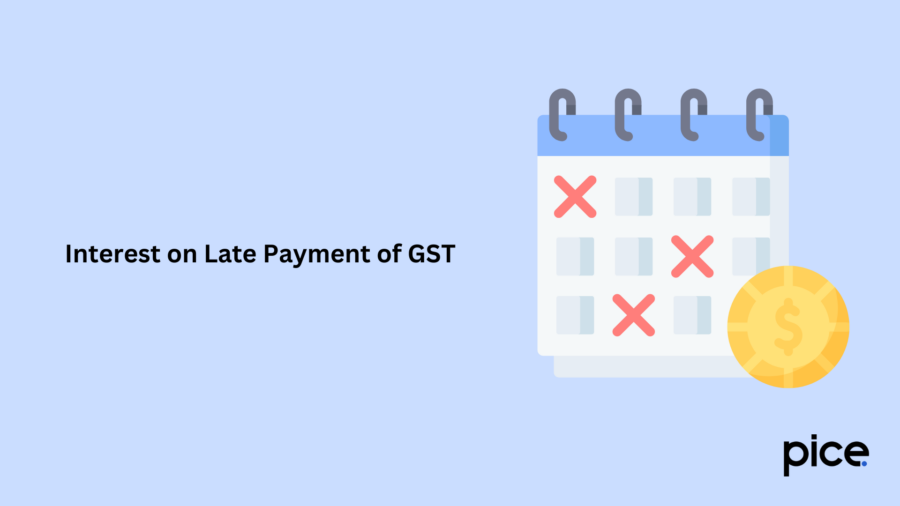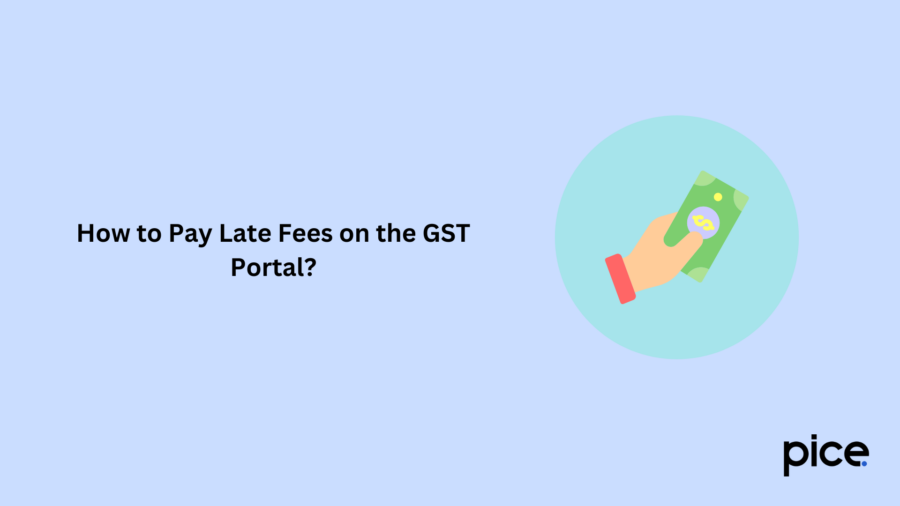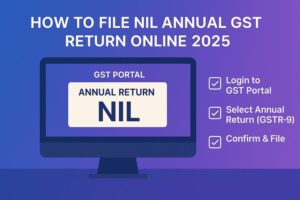Late Fees and Interest on GST Returns
- 27 Jan 25
- 15 mins

Late Fees and Interest on GST Returns
- Taxpayer Due Dates Under GST
- Interest on Late Payment of GST
- What Are Late Fees Under GST?
- Late Fees and Penalties Under GST
- Late Fee Computation for GSTR-3B and GSTR-1
- Late Fees for GST Annual Return (GSTR-9)
- Maximum Amount of Late Fees under GST
- List of Late Fee Notifications up to 2021
- How to Pay Late Fees on the GST Portal?
- Rules Applicable for GST Payment for Taxpayers
- Conclusion
Key Takeaways
- File GST returns on time to avoid penalties, late fees, and interest.
- Interest rates: 18% for late payments, 24% for excess ITC claims.
- Late fees range from ₹10 to ₹200/day, capped based on turnover.
- Reduced late fees apply from June 2021 for GSTR-1 and GSTR-3B.
- Late fees must be paid before filing GST returns on the portal.
The Goods and Services Tax (GST) is a well-established, full-scale taxation system in India that aims to streamline the tax payment process in the country. It is constituted by an all-encompassing indirect tax levied on goods and services supply.
All businesses are liable to pay tax and file for GST returns. However, when a business fails to pay the tax liability in a timely manner or does not file a GST return, it becomes prone to the payment of a penalty.
The department shall charge late fees and interest. Therefore, understanding the implications and different aspects of such a scenario is important for businesses. Read this comprehensive blog for all the information regarding late fees and interest under GST.
Taxpayer Due Dates Under GST

Before we get into the specifics, it's important to note that the due dates for filing GST returns depend on two factors. Here are the factors which determine GST return due dates:
- Type of return forms
- Type of taxpayer
The table below specifies the return form type and the corresponding due dates:
| GST Return Form | Due Date |
| GSTR-1 (Monthly) | 11th of the following month |
| GSTR-1 (Quarterly) | 13th of the month which succeeds the quarter |
| GSTR-3B (Monthly) | 20th of the following month |
| GSTR-3B (Quarterly) | 22nd or 24th of month which succeeds the quarter (Applies to taxpayers with an aggregate turnover that is equal to or below ₹ 5 crore; are eligible and stay opted for the QRMP scheme; 22nd of the month that follows the quarter for taxpayers in category X states/UTs*; 24th of the month following the quarter for liable individuals in category Y states/UTs*) |
| CMP-08 (Quarterly) | 18th of the month which succeeds the quarter |
| GSTR-4 (Annual) | 30th of June which succeeds the financial year, FY 2024-25(Note: Previously, the due date was the 30th of April which succeeded the financial year) |
| GSTR-5 (Monthly) | 13th of the following month |
| GSTR-5A (Monthly) | 20th of the following month |
| GSTR-6 (Monthly) | 13th of the following month |
| GSTR-7 (Monthly) | 10th of the following month |
| GSTR-8 (Monthly) | 10th of the following month |
| GSTR-9 (Annual) | 31st December of the following financial year |
| GSTR-9B (Annual) | 31st December of the following financial year |
| GSTR-9C (Annual) | 31st December of the following financial year |
| GSTR-10 (One time) | Within three 3 months of the date of cancellation of the GST registration; or the date of cancellation order (depends on whichever comes later) |
| ITC-04 (Annual/Half-yearly) | 25th April of the following financial year, where AATO is up to ₹5 crore; 25th October of the same financial year or Apr-Sep and 25th April of the following financial year for Oct-Mar, where AATO exceeds ₹5 crore |
*Category X States/UTs: Karnataka, Madhya Pradesh, Goa, Kerala, Tamil Nadu, Chhattisgarh, Gujarat, Telangana or Andhra Pradesh or the Union territories of Daman and Diu and Dadra and Nagar Haveli, Maharashtra, Puducherry, Lakshadweep, and Andaman and Nicobar Islands.
*Category Y States/UTs: Himachal Pradesh, Uttarakhand, Punjab, Haryana, Uttar Pradesh, Bihar, Rajasthan, Sikkim, Nagaland, Ladakh, Arunachal Pradesh, Manipur, Mizoram, Meghalaya, Assam, Tripura, West Bengal, Odisha or Jharkhand or the Union Territories of Jammu and Kashmir, New Delhi and Chandigarh
Interest on Late Payment of GST

An interest charge is applicable when a certain taxpayer fails to pay the respective GST amount by the established due date. The interest amount is added to the late payment of GST liability, resulting in the net tax liability once the reduction of the input tax credit claims is made. Here are the conditions under which the taxpayer has to pay an interest on GST:
- When the taxpayer claims excess input tax credit
- When the individual reduces the excess output tax liability
- When the taxpayer delays the GST payment (meets SGST, CGST or IGST after the pre-determined due date)
Under the above-mentioned circumstances, the interest rates apply as follows:
| Circumstances/Particulars | Interest Rate Applicable |
| When tax is paid after the due date | 18% per annum |
| In the case of excess ITC claim or excess reduction of Output Tax | 24% per annum |
What Are Late Fees Under GST?
GST laws in India established that a late fee amount is to be charged if one delays filing for the GST returns. This penalty is essentially levied upon the taxpayer for missing the due date assigned against filing GST returns.
Additionally, a late fee is applicable if the taxpayer delays in filing nil returns. To elaborate on the same, one is obliged to pay a late penalty amount even if there were no purchases/sales or no GST liability to declare under the GSTR-3B.
The late fee amount is decided based on the number of days delayed starting from the due date. The authority-wielding department, in this case, prescribes the late fee amounts that are to be charged each day crossed off after the set due date (refer to the list provided in the above section).
Here is an example for better understanding on your end: Say that the GSTR-3B is filed on 25th January 2024; that is 5 days post the prescribed due date (20th January 2024). In this case, the late fee amount will be applicable for 5 days and must be deposited in cash form.
The GST portal shall charge a penalty fee on GST returns, including:
- GSTR-1
- GSTR-3B
- GSTR-4
- GSTR-5
- GSTR-5A
- GSTR-6
- GSTR-8
- GSTR-7
- GSTR-9
Late Fees and Penalties Under GST
Below is an all-inclusive list quoting the penalties and late fees under the GST system in India, applicable to a scenario where there is delayed filing of GST returns (post-due dates).
Late Fee Computation for GSTR-3B and GSTR-1

GST Act states that for intrastate supplies, a late fee is applicable under both the SGST and CGST Acts as follows:
| Act in question | Late fees Applicable for each day of delay |
| Central Goods and Services Act, 2017 | ₹25 |
| Respective State Goods and Services Act, 2017/ Union Territory Goods and Services Act, 2017 | ₹25 |
| The total amount of late fines to be paid each day | ₹50 |
Note that the law has a fixed amount of maximum late fees established, at ₹10,000 (up to May 2021). So, the maximum late fees chargeable by the Government is ₹5,000 for any return filed under an Act.
However, the maximum late fee has been further rationalised from the month of June 2021 (return period onwards).
For nil return filers, the below-mentioned late fee shall apply:
| Act in question | Late fees Applicable for each day of delay |
| CGST Act | ₹10 |
| SGST Act | ₹10 |
| The total amount of late fines to be paid each day | ₹20 |
In this case, the maximum late fee has been rationalised for the GSTR-1 and the GSTR-3B from June 2021 (return period onwards).
Late Fees for GST Annual Return (GSTR-9)
| Act in Question | For taxpayers with turnover up to ₹5 crore(Late fees for each day of delay) | For taxpayers with turnover above ₹5 crores and up to ₹20 crore(Late fees for each day of delay) | For taxpayers with turnover above ₹20 crore(Late fees for each day of delay) |
| Central Goods and Services Act, 2017 | ₹25 | ₹50 | ₹100 |
| Respective State Goods and Services Act, 2017/ Union Territory Goods and Services Act, 2017 | ₹25 | ₹50 | ₹100 |
| Total Amount of Late fees to be paid | ₹50 | ₹100 | ₹200 |
| The maximum amount of late fees that can be charged | 0.04% of the turnover in state/ union territory | 0.04% of the turnover in state/ union territory | 0.25% of turnover for the respective financial year |
The CBIC has issued a notification (07/2023). It states that the Central Tax must reduce the late fee for delayed GSTR-9 filing, starting FY 2022-23. Here is the reduced late fee structure for GSTR-9 applicable from FY 2022-23:
- Taxpayers with Annual Aggregate Turnover (AATO) up to ₹5 crore shall pay ₹50 per day subject (maximum of 0.04% of turnover in state/UT).
- Taxpayers with Annual Aggregate Turnover above ₹5 crore and up to ₹20 crore are to pay ₹100 per day (maximum of 0.04% of turnover in state/ UT).
Taxpayers who are going to file pending GSTR-9 for the financial years 2017-18, 2018-19, 2019-20, 2020-21 and 2021-22 are required to pay a maximum late fee of ₹20,000. Note that the reduced late fee structure applies when one files pending GSTR-9 between the dates 1st April 2023 - 30th June 2023.
Maximum Amount of Late Fees under GST
According to the 43rd GST Council meeting, a maximum late fee will be reduced to certain amounts on the basis of the type of return as well as a turnover slab. This will be notified through the CGST notifications 19/2021, 20/2021, 21/2021 (dated 1st June 2021 for GSTR-3B and GSTR-1).
| Return Name | Return Type | Annual turnover of the past year | Maximum late fee applicable under CGST | Maximum late fee applicable under SGST | Maximum late fee in total |
| GSTR-1, GSTR-3B | Nil return | Not Applicable | ₹250 | ₹250 | ₹500 |
| GSTR-1, GSTR-3B | Other than Nil return | Upto ₹1.5 crore | ₹1,000 | ₹1,000 | ₹2,000 |
| GSTR-1, GSTR-3B | Other than Nil return | Between ₹1.5 crore and ₹5 crore | ₹2,500 | ₹2,500 | ₹5,000 |
| GSTR-1, GSTR-3B | Other than Nil return | Above ₹5 crore | ₹5,000 | ₹5,000 | ₹10,000 |
| GSTR-4(Starting FY 21-22) | Nil return | Not Applicable | ₹250 | ₹250 | ₹500 |
| GSTR-4(Starting FY 21-22) | Other than Nil return | Not Applicable | ₹1,000 | ₹1,000 | ₹2,000 |
| GSTR-7(Filing of TDS under GST) | Not Applicable | Not Applicable | ₹1,000 | ₹1,000 | ₹2,000 |
According to the CGST notification 22/2021 dated 1st June 2021, the late fee applicable for GSTR-7 has been reduced from ₹200 to ₹50 per day of delay, per return and per act.
List of Late Fee Notifications up to 2021

This section shall list the changes made to the applicability of late charges.
- GSTR-1
- GSTR-3B
| Return period(s) Applicable | Late Fee Applicable |
| For monthly filers from June 2021 onwards; QRMP taxpayers from quarter-ended June 2021 onwards for | The maximum late fee has been reduced. It is fixed at ₹500 per return, for each nil filer. For the rest of the taxpayers, it is fixed according to turnover slabs. |
| From July 2017 up to April 2021 | Late fee based on conditional waiver for late filing of GSTR-3B. If filed between the dates 1st June - 31st August 2021, the maximum late fee charged will be ₹500 per act, per return. |
| Monthly filers between March and April 2021Quarterly filers between Jan - Mar 2021 | Late fee based on conditional waiver for the delay in filing GSTR-3BF; for taxpayers with turnover above ₹5 crore, there is no late fee applicable for 15 days of delay.In case there is a turnover of up to ₹5 crore, there is no late fee for up to 30 days of delay. |
| For turnover above ₹5 croreMay 2020 to July 2020For turnover up to or less than ₹ 5 croreFebruary 2020 to July 2020 | Maximum late fee of up to ₹500 per return filed post the dates mentioned in notification 52/2020 before 30th September 2020; nil returns shall not be charged a late fee. |
| 1. For turnover above ₹5 crore(February 2020 to April 2020)2. For turnover up to or less than ₹5 crore(February 2020 to July 2020)3. Pending for July 2017 to January 2020 | Numbers 1 and 2 are completely waived off if filed before the dates of June - September 2020.For case 3, the maximum late fee goes up to ₹500 per return filed between the dates of 1st July 2020 to 30th September 2020; nil return has no late fee associated. |
| February 2020 to April 2020 | Late fees waived off completely if filed before the specified dates between June - July 2020. |
| Starting October 2018 onwards | Reduced Late fees |
| July 2017 to September 2018 | Reduced Late feesUnder the condition: If filed after 31st Mar 2019 |
| July 2017 to September 2018 | Completely waived offUnder the Condition: If filed between 22nd Dec 2018 to 31st Mar 2019 |
| For the month of October 2017 only | Waived off completelyUnder the Condition: If GSTR-3B submission was made but not successfully filed because of a technical glitch |
| October 2017 to April 2018Filing of GSTR-3B was pending, by those who had submitted TRAN-1 to the GST portal, but were not able to file it by 27th Dec, 2017. | Completely waived offUnder the Condition: If registered persons file for the declaration in TRAN-1 on/ before 10th May 2018; the return in GSTR-3B for every month, on or before the 31st May 2018 |
| Starting October 2017 onwards | Reduced Late feeUnder the Condition: If the date of filing had landed before 22nd December 2018 |
| July 2017 to September 2017 | Completely waived offUnder the Condition: If the date of filing had landed before 22nd December 2018 |
- GSTR-4 (Annual)
| Return period(s) Applicable | Late Fee Applicable |
| Beginning FY 2021-22 onwards | A maximum late fee amount which can be charged is restricted to ₹500 per return for nil filing; ₹2,000 for filing other than nil filing. |
- GSTR-5
| Return period(s) Applicable | Late Fee Applicable |
| From July 2017 onwards | Late fee is reduced |
- GSTR-5A
| Return period(s) Applicable | Late Fee Applicable |
| Returns from July 2017 onwards that are filed on/ after 7th Mar, 2018 | Full late fee is applicable |
| From July 2017 onwards | Late fee is reduced |
- GSTR-6
| Return period(s) Applicable | Late Fee Applicable |
| July 2019 | The late fees are completely waived off for taxpayers, situated within specific districts of the flood-prone states and all the districts of Jammu & Kashmir. |
| Any tax period that comes prior to January 2018 | Waived off completely |
| Starting July 2017 onwards | Late fee is reducedNo late fees are charged for delay in filing the Nil return |
How to Pay Late Fees on the GST Portal?

The late fee is supposed to be paid in cash, separately for CGST and for SGST. They are paid in separate electronic cash ledgers. One cannot file a GST return without paying the obligatory late fee first.
The applicable late fee shall be calculated automatically by the GST portal system while one submits their GST returns. A current month or quarter late fee needs to be paid when you file during the following month or quarter returns.
The late fee for a particular month will comprise the previous month’s late fee that had been charged owing to a delay in the filing of the return. Keep in mind that not paying or late payment of GST may lead to the piling of penalty interest.
Rules Applicable for GST Payment for Taxpayers
The rules that apply for GST payment may vary based on certain factors. For casual taxable persons, regular taxpayers, and composition scheme taxpayers, however, here are the main GST payment rules that apply:
- Casual Taxable Persons: Casual taxpayers are individuals who are only temporarily engaged in a business. They are required to register for GST. Plus, they must be able to pay taxes in advance, the amount calculated on the basis of their estimated liability. If one fails to pay taxes within a certain time period, they will incur penalties like regular taxpayers would.
- Regular Taxpayers: They are required to file GSTR-3B and GSTR-1. Filing will have to include payment of pending tax. This way, one can avoid late fees or additional interest.
- Composition Scheme Taxpayers: Taxpayers who are categorised under the composition scheme shall file returns yearly (GSTR-4). However, they are only required to make quarterly payments through CMP-08. Late payments, though, shall lead to piling of interest as well as penalties.
Note that taxpayers are required to maintain proper documentation in order to support the GST payments and claimed input tax credit.
Conclusion
As the landscape of taxation in India evolves, the understanding of the concept of GST return late fees and interest becomes even more important. Certain financial penalties apply, serving as a tough reminder of the significance of punctuality and compliance within the GST regime.
They reinstate the necessity of meeting deadlines and fulfilling tax obligations promptly. Thus, GST return filing shall remain a crucial step towards avoiding the piling of late fees and interest and efficient tax administration.
💡If you want to streamline your payment and make GST payments, consider using the PICE App. Explore the PICE App today and take your business to new heights.
 By
By 















